The SanDisk Ultra 3D is a new client SSD similar to that of the WD Blue 3D. Because this drive is on the lower end of the performance scale, its main application will be general upgrades from an HDD-based system to solid-state technology for faster boot up times and speedier overall performance. It should also be noted that WD has the same drive under its own brand, so this is essentially an identical SSD with a different sticker slapped on it.
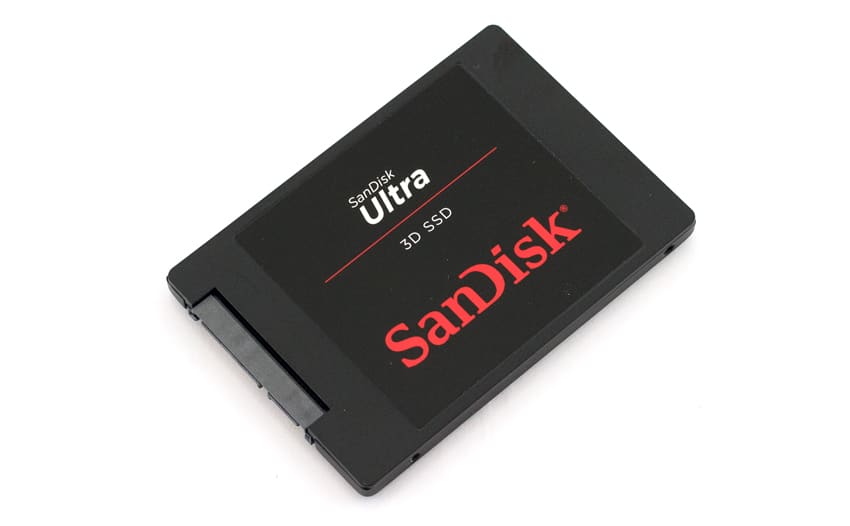
As its name indicates, SanDisk’s new SSD uses 3D NAND and nCache 2.0. It also features shock and vibration resistance for increased reliability. The SanDisk Ultra 3D SSD is managed through the company’s Dashboard, which gives users real-time visibility into how the drive is performing as well as cloning software, tools for disk analysis, and alerts for firmware updates. SanDisk quotes the Ultra 3D with up to 560MB/s and 530MB/s in sequential read and write speeds respectively (550MB/s and 525MB/s for the 250GB model) while random reads and writes throughput is expected to reach up to 95,000 IOPS and 84,000 IOPS, respectively.
Backed by a 3-year warranty, the SanDisk Ultra 3D comes in capacities of 250GB, 500GB, 1TB, and 2TB with prices ranging from as little as $99 to $550. For our review we will be looking at the 1TB model.
SanDisk Ultra 3D Specifications
- Interface: SATA Revision 3.0 (6Gb/s)
- Available capacities: 250GB, 500GB, 1TB, 2TB
- Seq. Read (up to): 550MB/s, 560MB/s, 560MB/s, 560MB/s
- Seq. Write (up to): 525MB/s ,530MB/s, 530MB/s, 530MB/s
- Rnd. Read (up to): 95K IOPS, 95K IOPS, 95K IOPS, 95K IOPS
- Rnd. Write (up to): 81K IOPS, 84K IOPS, 84K IOPS, 84K IOPS
- TBW: 100, 200, 400, 500
- Dimensions: 2.75 x 3.96 x 0.28 in. (69.95 mm x 100.5 mm x 7.0 mm)
- Operating temperature: 32ºF to 158ºF (0ºC to 70 ºC)
- Shock Resistant up to 1500 G @ 0.5 m/sec
- Vibration: 5 gRMS, 10-2000 HZ / 4.9 gRMS, 7-800 HZ
- Warranty: Limited 3-year warranty
Design and build
The SanDisk Ultra 3D uses a 7mm form factor and is identical to other SanDisk SSDs with the exception of the model name, as the company hasn’t changed the look of their drives for several years. As such, it has the usual smooth and refined black metal enclosure with white, black and red color scheme. As we mentioned above, SanDisk’s aluminum case is designed to resist shocks and vibrations to preserve data integrity.
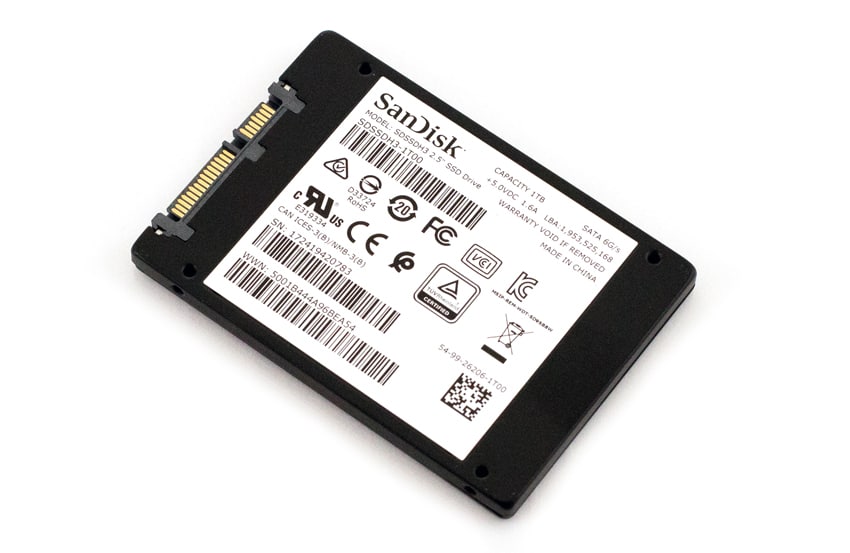
As it is identical to the WD Blue 3D SSD, we did not open up the case to see the inner workings that can be seen through that review.
Consumer Synthetic Benchmarks
All consumer SSD benchmarks are conducted using the StorageReview HP Z640 Workstation. We compared the SanDisk Ultra 3D SSD to the following drives:
- Intel 545S SSD (512GB)
- Samsung 850 Pro SSD (1TB)
- Samsung 850 Pro SSD (2TB)
- ADATA SU900 SSD (512GB)
- Crucial MX200 SSD (500GB)
- Crucial MX200 SSD (1TB)
- Micron M600 SSD (1TB)
- OCZ VX500 SSD (512GB)
- WD Blue SSD (1TB)
All IOMeter figures are represented as binary figures for MB/s speeds.
In our 2MB sequential benchmark, the SanDisk Ultra 3D came in second spot in reads behind the ADATA SU900 with a score of 505.63MB/s. For write performance the drive fourth with 460.69MB/s.
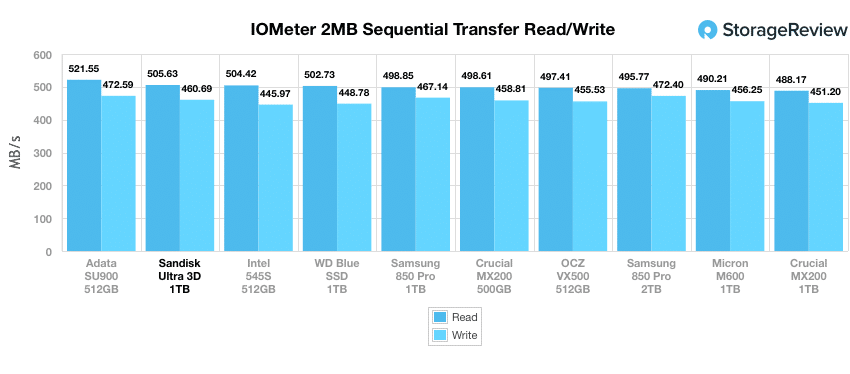
In our random 2MB benchmark, the SanDisk drive came in second to last in read performance with 432.28MB/s. With writes, the drive placed sixth with a score of 454.95MB/s.
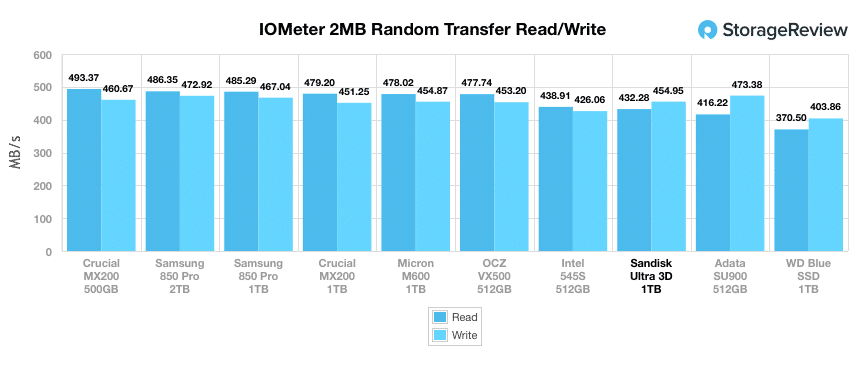
The purpose of our random 4k benchmark is to put more strain on the drives in terms of throughput. Under these conditions, the SanDisk placed right in the middle of the pack with a read performance of 32.84MB/s and 111.51MB/s write.
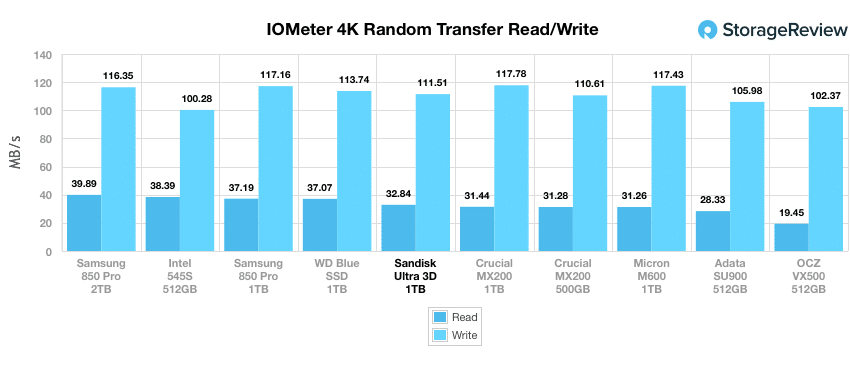
With the same test looking at IOPS, the SanDisk again placed in the middle with a read score of 8,406.19 IOPS and a write score of 28,546.03 IOPS.
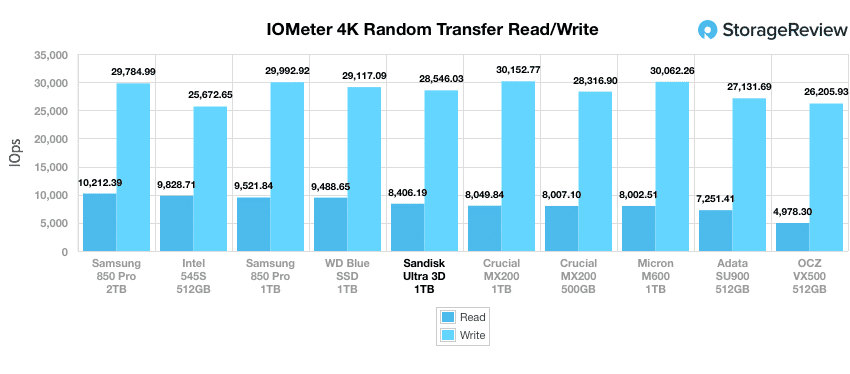
In terms of our 4K write latency benchmark, the SanDisk had an average latency of 0.0349ms placing it sixth and a max latency of only 1.21ms placing it third.
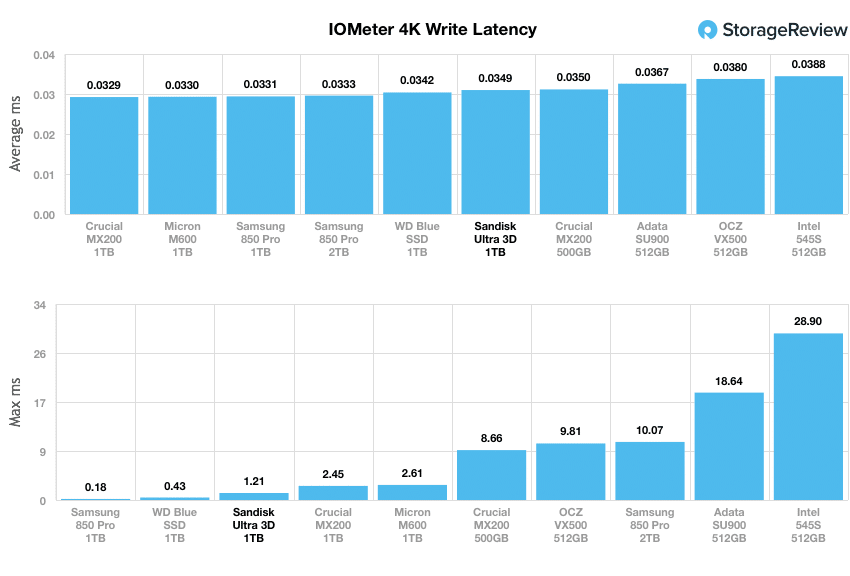
For our next 4K test, we move to a workload with 100% write activity, which scales from 1QD to 64QD. Here the SanDisk ran around the middle of the pack throughout peaking at about 74K IOPS.
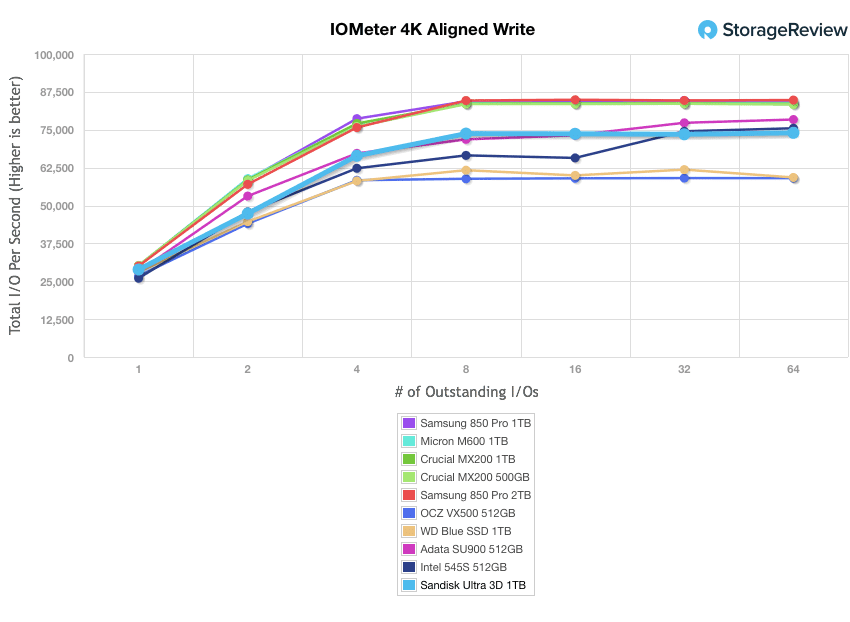
In our 4k aligned write the SanDisk performed much better finishing third overall with a peak score of 95.6K IOPS.
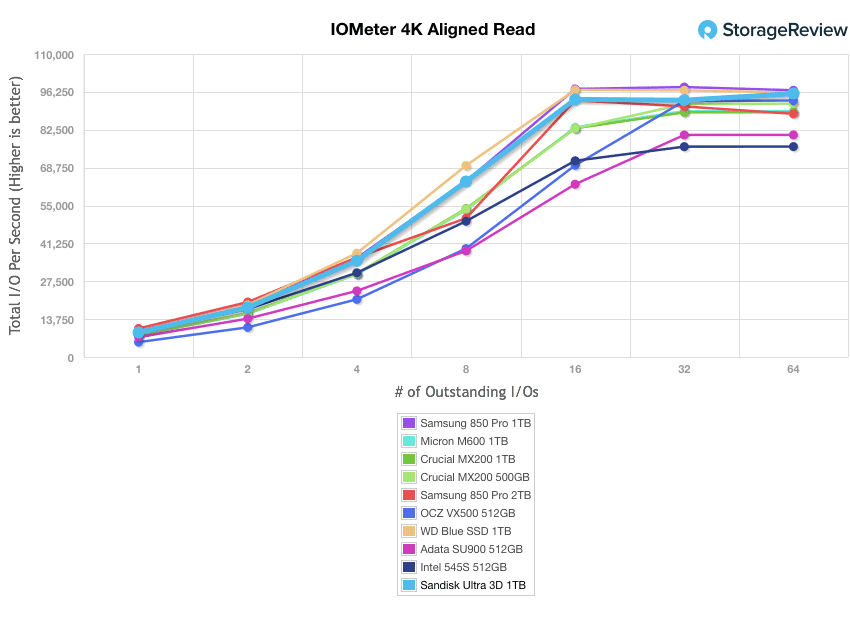
Our final consumer-synthetic benchmarks compare the drives in a series of mixed-server workloads with a queue depth of 1 to 128. Each server profile has a strong bias towards read activity, ranging from 67% read with the database profile to 100% read in the web server profile.
The database profile features a 67% read and 33% write workload, focusing on transfers around 8K in size. The SanDisk ran near the bottom of the pack though it did beat the WD Blue in performance. The SanDisk peaked at 33K IOPS.
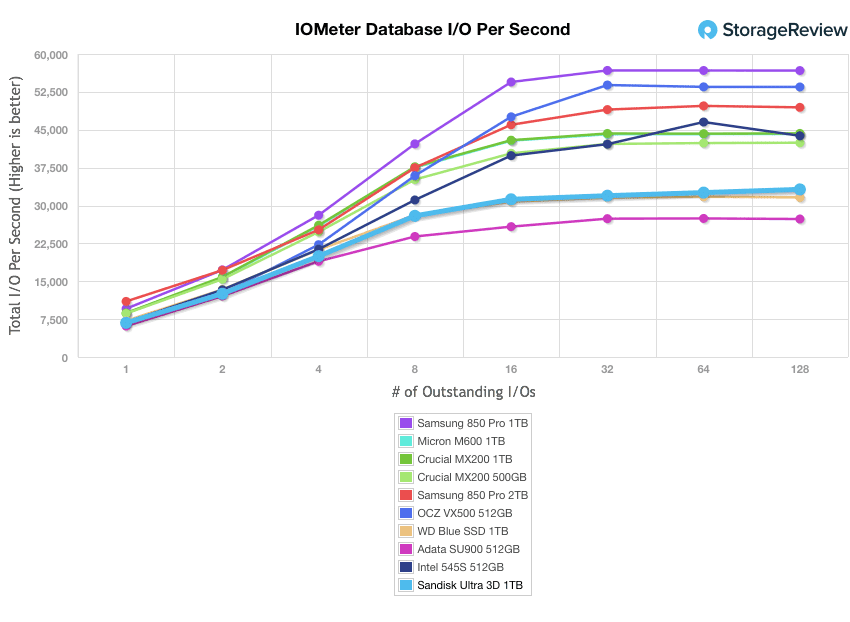
Our next benchmark is the read-only web-server profile, which uses transfer sizes ranging from 512 bytes to 512KB. Here the SanDisk found itself in the middle of the pack with a peak score of 21K IOPS.
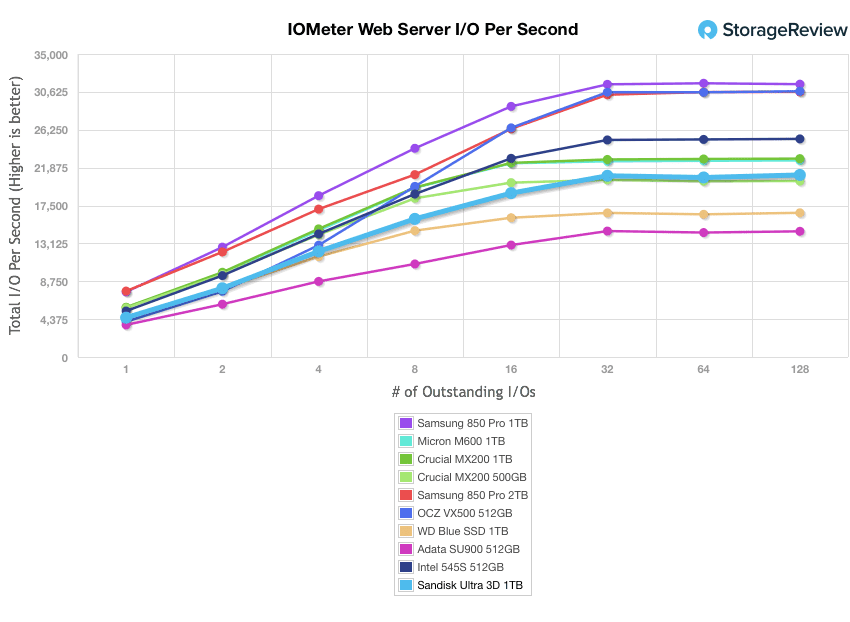
During the file-server profile, which has 80% read and 20% write workload spread out over multiple transfer sizes ranging from 512-bytes to 64KB, the SanDisk found itself hanging with a rough crowd of low performers. The drive came in third with a peak score of 28K IOPS.
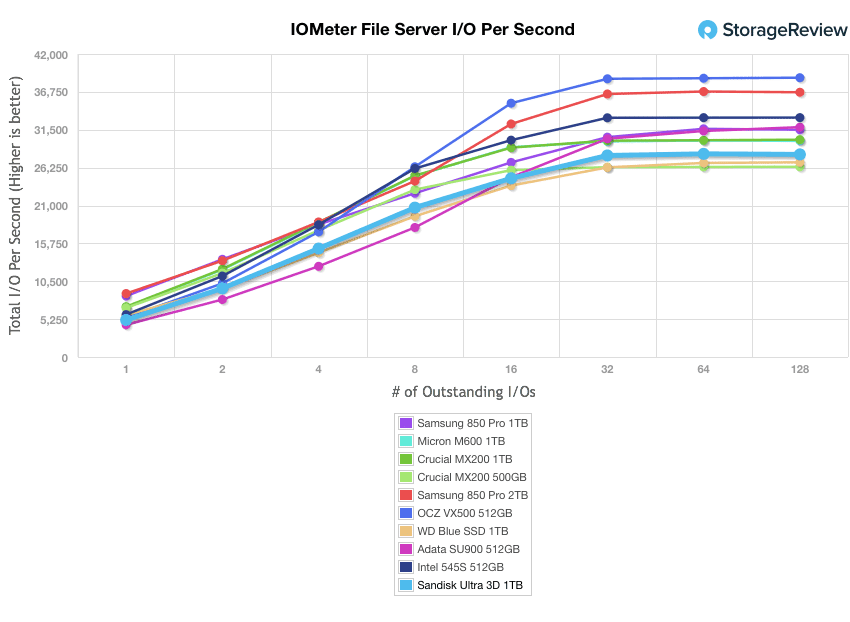
The last profile looks at workstation activity, with a 20% write and 80% read mixture using 8K transfers. The SanDisk was nearly matching the poor performance of the WD Blue, though slightly worse with a peak score of 32K IOPS.
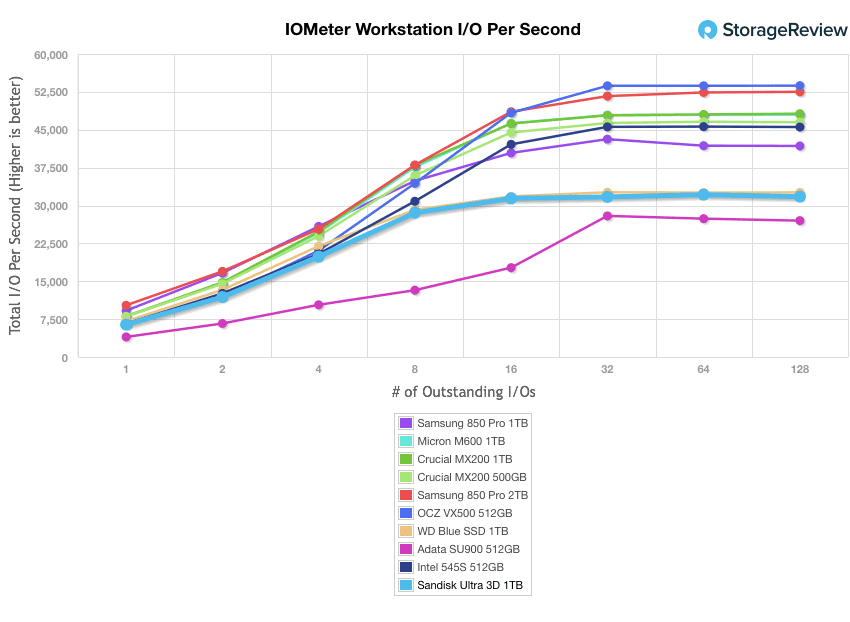
Consumer Real-World Benchmarks
While the results of synthetic benchmarks are important in identifying the key strengths and weaknesses of a drive, performance in these tests does not always translate directly into real-world situations. To get a better idea how the SanDisk Ultra 3D drive will handle itself in the field, we will chart StorageMark 2010 HTPC, Productivity, and Gaming traces against comparable drives. Higher IOPS and MB/s rates with lower latency times are preferred.
The first trace is based on use as a Home Theater PC (HTPC). The test includes playing one 720P HD movie in Media Player Classic, one 480P SD movie playing in VLC, three movies downloading simultaneously through iTunes, and one 1080i HDTV stream being recorded through Windows Media Center over a 15-minute period.
In our HTPC profile, the SanDisk performed in the upper end of the pack with scores of 7,739 IOPS, 353.31MB/s, and an average latency of 1.004ms. This is a fairly big improvement over the WD Blue.
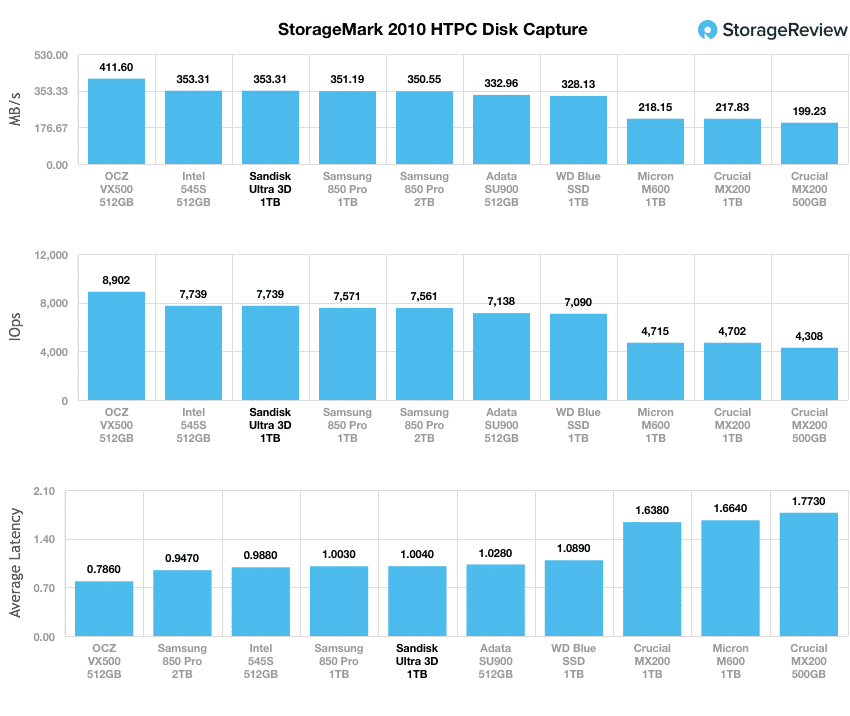
The next trace simulates disk activity in an office workstation or productivity scenario. This test includes three hours of operation in an office productivity environment with 32-bit Windows Vista running Outlook 2007 connected to an Exchange server, web browsing using Chrome and IE8, editing files within Office 2007, viewing PDFs in Adobe Reader, an hour of local music playback, and two hours of streaming music via Pandora.
In the productivity trace, the SanDisk Ultra found itself in the middle of the pack with scores of 7,320 IOPS, 216.82MB/s, and an average latency of 1.059ms. Again improving upon the WD Blue.
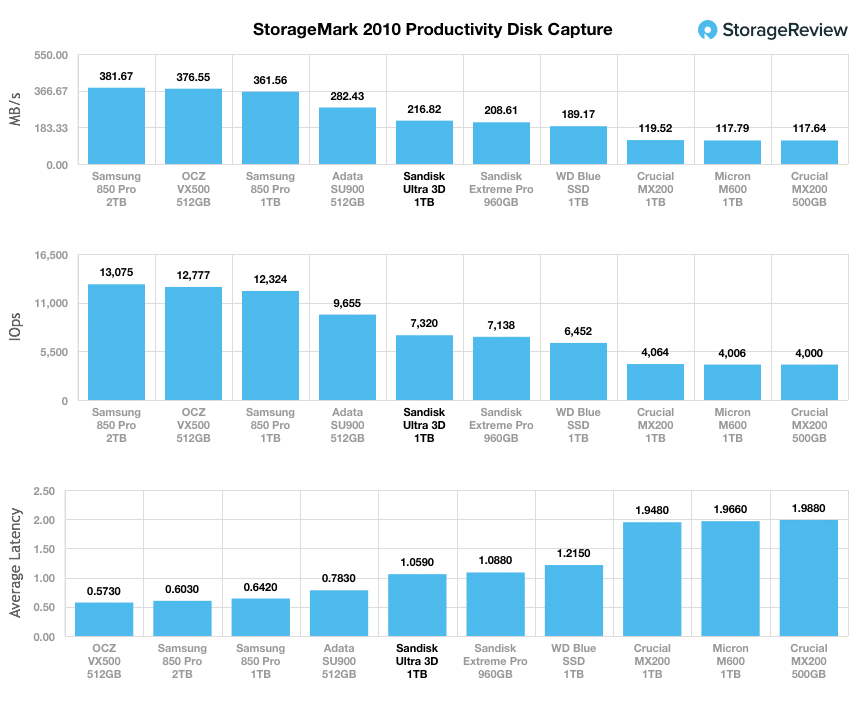
The final consumer real-life benchmark simulates disk activity during gaming. This simulation taxes the drive’s read performance, with 6% write operations and 94% read operations. The test consists of a Windows 7 Ultimate 64-bit system pre-configured with Steam, with Grand Theft Auto 4, Left 4 Dead 2, and Mass Effect 2 already downloaded and installed. The trace captures the heavy read activity of each game loading from the start, as well as textures as the game progresses.
In our gaming benchmark, the SanDisk found itself near the bottom once more with scores of 8,020 IOPS, 431.65MB/s, and an average latency of 0.966ms.
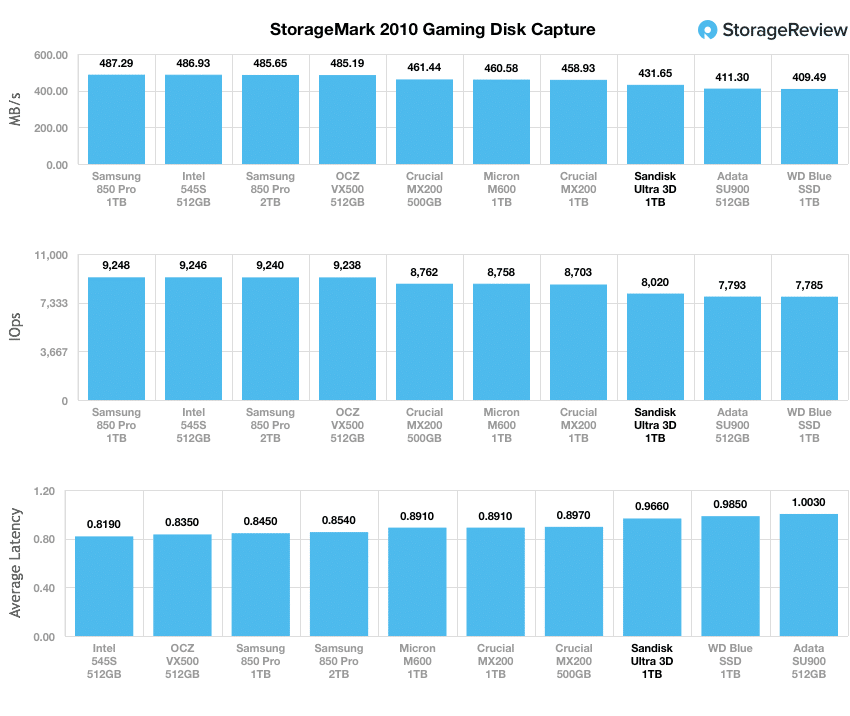
Conclusion
The SanDisk Ultra 3D is a client SSD that leverages 3D NAND that is being marketed as an HDD replacement. As with most SSDs, users will see an improvement in performance, boot time, endurance, and a reduction in latency swapping out their HDD for flash. The drive comes in 250GB, 500GB, 1TB, and 2TB capacities. It will also come with shock and vibration resistance and SanDisk software like SSD Dashboard. The drive is more or less identical SanDisk version of the WD Blue 3D SSD leveraging the same NAND in a branded model.
Looking at performance the drive is more or less average to below average. The drive started off with fairly strong 2MB sequential performance (505.63MB/s read and 460.69MB/s write). In our first set of 4k benchmarks the drive found itself in the middle of the pack with one shining moment of decent max latency of 1.21ms. Aligned write gave an average performance while the drive placed in the top three for aligned read. In our mixed workload benchmarks the SanDisk Ultra had one good placement (in the middle) in read-centric web-server and fell in the bottom of the pack with the other three with a heavier write focus. In our consumer real-world benchmarks the SanDisk had a decent HTPC score, medium productivity score, and a bottom of the pack gaming score.
Pros
- Improves its performance over the WD Blue non-3D NAND model it replaces
- 2TB model aligns with other industry leading capacity offers
Cons
- Less than impressive benchmark numbers
- Lower 3-year warranty versus others at 5-years
The Bottom Line
The SanDisk Ultra 3D SSD is an improvement over the WD Blue and will work as an HDD replacement at an attractive price point.




 Amazon
Amazon